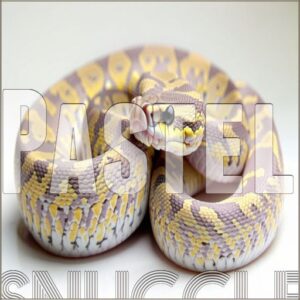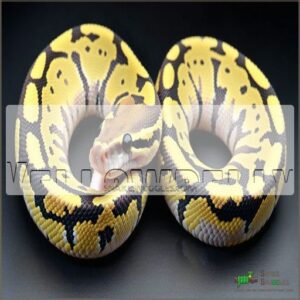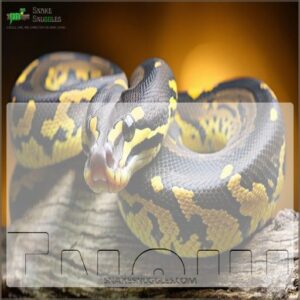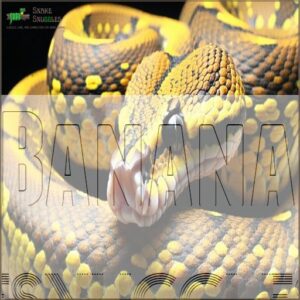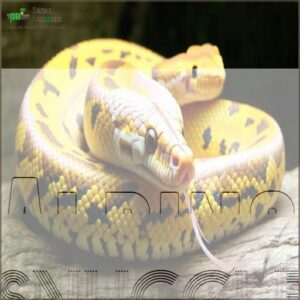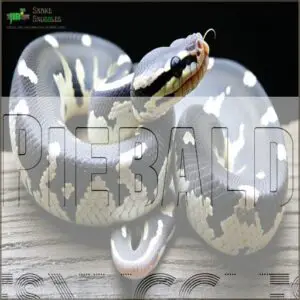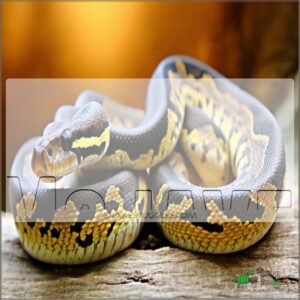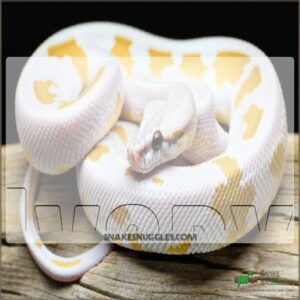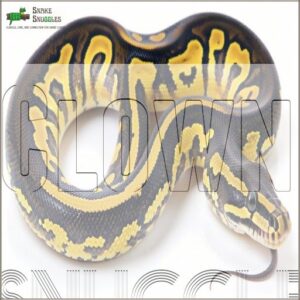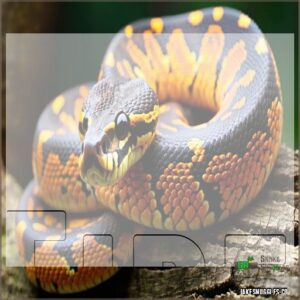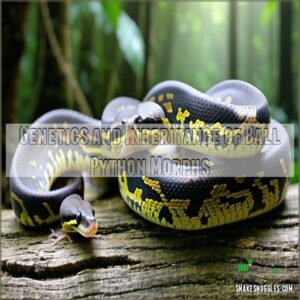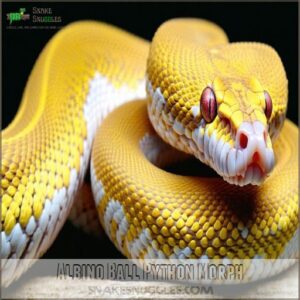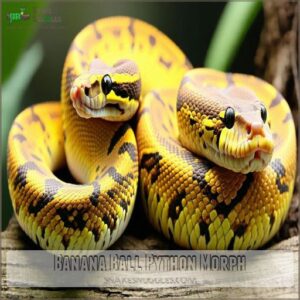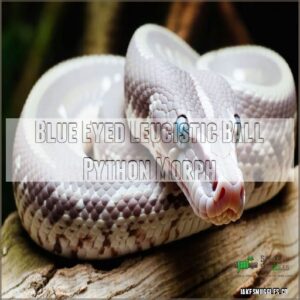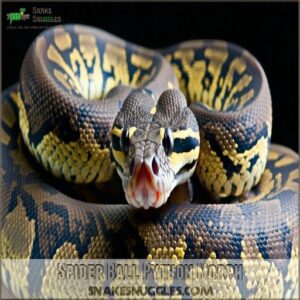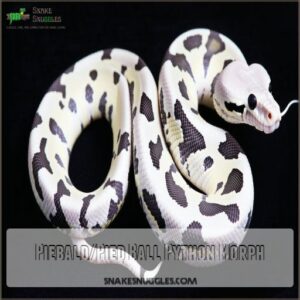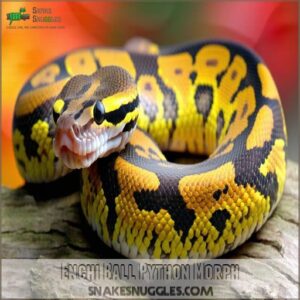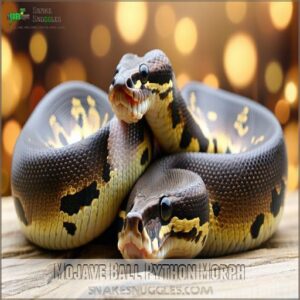This site is supported by our readers. We may earn a commission, at no cost to you, if you purchase through links.
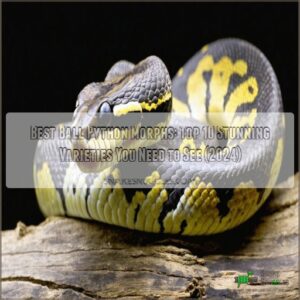 Looking for the best ball python morphs to dazzle your collection?
Looking for the best ball python morphs to dazzle your collection?
Whether you’re a seasoned herp enthusiast or just slithering into the hobby, these morphs are show-stoppers.
The Pastel morph lights up any collection with its vivid yellow and caramel tones—perfect for blending into breeding projects.
Meanwhile, the Banana morph adds a splash of sunshine, boasting freckles like a banana on a beach holiday.
Albinos impress with their striking lack of melanin, creating a yellow-orange spectacle.
And don’t sleep on Piebalds; their white patches against darker hues are nature’s own abstract art.
Hungry for more snake knowledge? Stick around!
Table Of Contents
- Key Takeaways
- Most Popular Ball Python Morphs
- Unique and Rare Ball Python Morphs
- Genetics and Inheritance of Ball Python Morphs
- Albino Ball Python Morph
- Banana Ball Python Morph
- Blue Eyed Leucistic Ball Python Morph
- Spider Ball Python Morph
- Piebald/Pied Ball Python Morph
- Enchi Ball Python Morph
- Mojave Ball Python Morph
- Frequently Asked Questions (FAQs)
- What are ball python morphs?
- What are the most popular ball python colors & morphs?
- What is the best ball python morph?
- Why are ball python morphs so popular?
- How many types of ball python morphs are there?
- How do I choose a ball python morph?
- What is the best morph of ball in python?
- What ball python morphs to avoid?
- Are male or female ball pythons better?
- What is a ghi ball python?
- Conclusion
Key Takeaways
- You’ll find many popular ball python morphs, including Pastel, Yellowbelly, Enchi, and Banana, each with unique color and pattern characteristics.
- Rare morphs like Piebald, Mojave, Ivory, and Clown offer striking visuals but can be more expensive and challenging to care for.
- Understanding ball python genetics—recessive, dominant, co-dominant, and polygenetic inheritance—helps you predict offspring traits and make informed breeding decisions.
- While many morphs are visually stunning, some, like the Spider morph, carry neurological issues; responsible breeding practices are crucial.
Most Popular Ball Python Morphs
You’ll find endless color combinations in these popular ball python morphs, from the bright yellow Banana to the striking white Albino variants that’ll make your friends wonder if you’re housing a living rainbow.
Top morphs that experienced breeders can’t stop talking about, including favorites like Pastel, Yellowbelly, and Enchi.
Pastel
Pastel ball pythons burst with stunning yellow and caramel tones that’ll catch your eye instantly.
You’ll love how their bright patterns pop against their lightened base color, creating a truly eye-catching snake.
Pastel ball pythons are a co-dominant morph, making them perfect for breeding projects and creating designer combinations.
The best part? These beautiful pythons are readily available and won’t break the bank, making them ideal for both beginners and experienced keepers.
Yellowbelly
The breathtaking beauty of Yellowbelly ball pythons lies in their distinctive belly scales, featuring a rich, buttery-yellow hue that sets them apart from other morphs.
You’ll instantly recognize these stunning serpents by their signature traits:
- Cream-colored belly scales with unique speckled patterns
- Enhanced contrast between light and dark markings
- Reduced dark pigmentation along their sides
- Subtle golden undertones throughout their body
Enchi
If you’re exploring ball python morphs, the Enchi morph is one that might just captivate you with its vibrant colors and bold patterns, featuring stunning golden-yellow sides and a unique copper-bronze coloration in their alien heads pattern.
This morph, known for enhancing yellows, oranges, and browns, offers exciting possibilities in breeding, such as learning more about the Enchi gene and its expression at Enchi Ball Python care.
With Enchi genetics, you can even explore creating Super Enchis for more striking visuals on the morph market.
Banana
You know how some snakes just get all the attention at the party?
That’s the banana ball python for you.
With its stunning yellow hues, orangey-brown patterns, and unique freckles, this morph is a must-have.
Whether you’re into breeding for brighter shades or just want a vibrant pet, banana morphs deliver charm and intrigue.
Albino
Albino ball pythons captivate with their striking yellowish orange bodies and pinkish red eyes, thanks to a recessive genetic twist that lacks melanin.
Albino ball pythons don’t just add flair; they’re a fascinating study in ball python morph genetics and care.
When caring for one, prioritize a cozy environment with the right heat and light, plus a balanced diet.
Unique and Rare Ball Python Morphs
You’re in for a treat with unique and rare ball python morphs that stand out with their vibrant colors and distinct patterns.
Imagine caring for a pet that looks like it’s been painted by an artistic genius—these morphs offer just that with each one telling its own colorful story.
Piebald
Imagine gazing at a snake with a design straight from a painter’s dream.
The piebald ball python is a masterpiece of white patches set against its dark canvas, each unique and striking.
It’s like a living, breathing work of art needing careful attention to remain vibrant.
Piebald Breeding requires patience, as their intriguing recessive genetics demand mindful pairing – but the reward is priceless.
Mojave
If you’ve got a sweet spot for exotic pets, the Mojave ball python will captivate you with its caramel-like hues and bold, contrasting brown blotches.
These snakes are a gem among ball python morphs and can be quite the catch for any enthusiast.
While Mojave prices vary, their striking appearance and adaptability make them worth every penny.
Ivory
Ever seen an Ivory Ball Python?
These beauties boast a striking white body, sometimes with subtle tan highlights.
Their rarity makes them pricey, but their unique look is worth the investment, with prices often reflecting their rare genetic value.
Caring for them is similar to other ball pythons.
Breeding Ivories requires expertise, making them a challenge for even seasoned keepers.
Their value? Pretty high!
Clown
When you explore the mesmerizing world of ball python morphs, the Clown morph stands out with its striking patterns and vibrant personality. Sporting bold jigsaw puzzle-like patches over a clean white base, it’s certainly a head-turner.
- Clown Morph History: Originates from a fascinating genetic mutation.
- Availability: It’s a bit of a collector’s item.
- Caring for Clowns: Requires attention to patterns and colors.
- Genetics and Pricing: Rare, with a distinct lineage that’s highly sought after.
Looking for a snake that makes a statement? The Clown morph might just be your showstopper!
Fire
Picture a ball python with fiery flair and visual appeal that resonates with reptile enthusiasts.
The Fire morph, with its dazzling orange and red tones, brightens your ball python morph collection.
This morph falls under the incomplete dominant category and uniquely enhances patterns without causing issues like the Spider morph might.
It’s perfect for creating vivid combos like the Firefly.
Genetics and Inheritance of Ball Python Morphs
Understanding the genetics of ball python morphs is like being a snake whisperer; it reveals the secrets to predicting which stunning traits might appear in the next generation.
Recessive, dominant, and co-dominant morphs are terms that will soon have you sounding like a herpetologist at a cocktail party, impressing everyone with your knowledge of these fascinating creatures.
Simple Recessive
Let’s explore simple recessive ball python morphs.
Think of these genetic wonders as requiring two identical keys to reveal their visual magic, similar to how Albino Ball Pythons showcase recessive inheritance with their unique yellowish-orange body coloration.
You need two recessive genes for traits like albino or piebald to shine.
These traits can’t hide—only express when paired right.
Understanding recessives opens up exciting possibilities in morph combinations and ethical breeding strategies.
Dominant
In ball python genetics, dominant morphs like Spider and Pinstripe are fascinating because their unique traits shine through with just one mutant gene.
Even if paired with a normal snake, their offspring might grab some of that flair.
It’s like these snakes have a secret recipe for looking cool!
They’re a perfect example of dominant gene expression in action.
Incomplete Dominant / Co-Dominant
When thinking about ball python morphs, understanding how genetics like incomplete dominance and codominance play out is fascinating.
These terms describe how a single mutant gene or a blend of traits creates unique morphs.
You’ll find:
- Visual impact through morph blending
- Super forms enhancing gene expression
- Fascinating inheritance patterns in morph combinations
Dive deeper into this genetic marvel!
Polygenetic
So, you’re ready to tackle more complex ball python morph genetics?
Polygenetic inheritance means multiple genes work together, creating a crazy mix of colors and patterns!
Think of it as a recipe with lots of secret ingredients—you get amazing variety, but predicting the result can be tricky.
This explains why some morphs, like the mesmerizing Monsoon, have such unique color blends.
Breeding these complex beauties presents challenges, but the results are worth it!
Imagine the possibilities for future morphs!
Albino Ball Python Morph
You’ll find the Albino Ball Python morph absolutely mesmerizing with its yellowish-orange body and striking pinkish-red eyes.
It lacks melanin pigment, giving it a unique and enchanting appearance that’s sure to brighten up your collection—just imagine it as the elegant ghost of the snake world!
Yellowish Orange Body
Ditch your preconceptions about reptiles with the albino ball python’s vibrant yellowish body.
Unlike other ball python morphs, this amelanistic wonder sports white patterns set against its radiant hues, offering a striking visual.
Its unique morph genetics make it a star.
Imagine the allure of a sunset on scales, far surpassing similar morphs in color and charm.
Pinkish Red Eyes
Albino ball pythons flaunt pinkish red eyes, a striking consequence of their unique Albino genetics and lack of melanin.
These eyes captivate with their vibrant hue but demand gentle lighting to maintain good eye health.
You’re not just managing a pet—you’re crafting a living masterpiece! Keep those stunning eyes in top shape with a little care and attention.
Lack of Melanin Pigment
Without melanin, albino snakes flash a dazzling white and yellow look with those unmistakable pinkish-red eyes, which can display varying levels of contrast, such as high contrast albinos with vibrant yellow and white patterns as discussed in albino ball python morphs.
Imagine a snake wearing sunglasses because it lacks its natural brown and black pigmentation.
Axanthic morphs, on the other hand, pull off a grayscale vibe.
These stunning color variations aren’t just eye candy; they tell stories of fascinating genetic mutations in reptiles.
Banana Ball Python Morph
You’ll immediately spot a Banana Ball Python with its bright yellow body adorned with orangey-brown patterns and charming freckles, giving it a look that’s hard to miss.
As you admire its sides, notice how they fade into softer tones, almost like a perfectly ripened banana—without the pesky need for a fruit basket!
Yellow Body
When you first spot the Banana Ball Python, its vibrant yellow body will draw you in like a golden sunrise.
This Yellow Morph stands out due to its brilliant hues amplified by banana genetics.
Breeding these beauties can result in a kaleidoscope of vibrant offspring, showcasing the magic of Ball Python Morph Combinations.
Orangey Brown Patterns
Banana ball pythons are mesmerizing.
Their orangey brown patterns are a highlight.
Think warm autumn leaves, but on a snake!
These aren’t just random splotches; they’re intricate, like a hidden code.
You’ll find:
- Rich, deep browns.
- Lighter, almost orangey sections.
- Variations in intensity—some areas bolder than others.
- A mesmerizing overall effect.
Faded Sides
Imagine your Banana Ball Python as if it’s wearing a pair of trendy faded jeans.
Those distinguished faded sides come from the Banana gene, making them stand out among ball python morphs.
Breeders love pairing Banana morphs to get that consistent, sought-after look.
Understanding these genetics is key for anyone keen on creating the next showstopper in their collection.
Freckles
Freckles on Banana ball pythons? They’re like nature’s sprinkle of pizzazz, adding charm and uniqueness to your snake collection. These tiny spots dance randomly across the yellow canvas, making each Banana stand out.
To further explore and understand the intricacies behind this unique pattern, enthusiasts often explore Freckle Morph products.
They may not affect health, but they boost freckle morph value and intrigue. Explore freckle genetics and discover endless possibilities in your ball python morph collection.
Blue Eyed Leucistic Ball Python Morph
If you’re looking for a truly stunning ball python, the Blue Eyed Leucistic might just take the cake with its dazzling white body and striking blue eyes.
It’s like owning a miniature, majestic snow dragon—only this one’s content to curl up and watch TV with you.
White Body
The Blue Eyed Leucistic morph, a real showstopper with its striking white body and piercing blue eyes, stands out in the python world.
Unlike the Albino’s complete lack of pigment, this one has a vibrant appeal, much like a star in a midnight sky.
You can find numerous products inspired by this stunning morph, including accessories and merchandise, at Blue Eyed Leucistic stores on Chewy.
This morph is the head-turner at any reptile gathering.
- Striking white body
- Piercing blue eyes
- Retains some pigmentation
- Popular and distinctive
Light Yellow/cream/purple Patterns
Beneath the immaculate white body, this snake flaunts a delicate harmony of light yellow, cream, and purple. These hues weave together like a symphony of pastels, enchanting and rare. Imagine merging a sunset’s gentle touch with the silky brush of a painter—patterns so subtle they’re almost dreamlike. It’s nature’s artwork on a reptilian canvas.
| Characteristics | Description |
|---|---|
| Body Color | White with light yellow |
| Pattern Details | Cream and purple accents |
| Appeal | High demand among collectors |
Piercing Blue Eyes
Imagine locking eyes with a Blue-Eyed Leucistic ball python.
Those piercing blues contrast strikingly with its white body.
This striking look stems from a recessive genetic mutation that breeders harness using Mojave, Lesser, and Butter morphs.
These leucistic ball pythons are like the supermodels of the snake world, commanding attention with every graceful slither.
Spider Ball Python Morph
You’ll be captivated by the Spider ball python‘s intricate web-like patterns, created by thin, elongated lines across its body.
Just remember, though, that this stunning morph often comes with a mild neurological condition causing a slight wobble—a quirky personality trait!
Intricate Web-like Patterns
Ever admired a ball python with a pattern like nature’s lacework? That’s the Spider morph for you. With web-like designs snaking across its body, it captivates many enthusiasts.
However, the Spider morph’s allure comes with a wobble—a neurological quirk. While some question the ethics of breeding this morph, others see it as a fascinating, though controversial, serpentine marvel.
| Morph | Pattern | Neurological Issues |
|---|---|---|
| Spider | Intricate web-like | Wobble syndrome |
| Pastel | Bright yellow | None |
| Piebald | Striking contrast of white and dark | None |
| Enchi | Enhanced colors and bold patterns | None |
Thin Elongated Lines
Spider ball python morphs showcase mesmerizing, thin elongated lines forming intricate web-like patterns, drawing you into their unique design.
These patterns, the handiwork of the Spider gene, add flair to your collection.
Mix them with other morphs like Pastel, Mojave, and Enchi, and you’ll get a canvas of stunning hues—a gentle reminder of nature’s genetic artistry at play.
Neurological Defect (wobble)
The spider morph’s thin, elongated lines are fascinating, but they bring along the notorious wobble. This neurological defect can affect a snake’s movement and feeding. Here’s what you might face as an owner:
- Wobble causes unusual head tilts.
- Wobble genetics means it’s inherited.
- Wobble impact can strain daily life.
- Wobble prevention requires careful breeding choices.
Piebald/Pied Ball Python Morph
When you meet the Piebald Ball Python, you’ll immediately notice its stunning contrast of pure white and dark pigmentation, like an abstract art masterpiece.
It’s almost as if the snake decided to wear a patchwork quilt, with its distinctive irregular white patches creating a one-of-a-kind look that’s hard to forget.
Striking Contrast of White and Dark Pigmentation
You’re captivated by bright whites against deep blacks, then those piebald ball pythons are your dream come true.
These snakes proudly display their stunning patchwork of light and dark, as if nature doodled joyously.
This remarkable color variation is pure eye candy for collectors, adding a lively touch to any collection and sparking endless fascination.
Irregular White Patches
Picture a piebald ball python, its irregular white patches like snowflakes on a dark canvas. This striking contrast isn’t random; it comes from a recessive gene affecting pigment.
For enthusiasts looking to bring one home, you can find a variety of products and accessories designed for their care at Piebald Ball Python essentials.
Curious about owning one? Consider these:
- Piebald Genetics: Understand recessive genes.
- Breeding Considerations: Health matters.
- Pattern and Care: Unique looks, gentle nature.
It’s not just a snake; it’s art in motion!
Enchi Ball Python Morph
You’ll find Enchi ball pythons fascinating, showcasing enhanced colors and bold patterns; think vibrant yellows, oranges, and browns – it’s like nature’s own paint palette went wild!
Enhanced Colors
With colors so enhanced, the Enchi morph is like turning up the saturation on nature’s palette.
Imagine vibrant yellows and oranges mingling in a mix worthy of a sunset.
Enchi combos, such as Enchi Pastel combinations, have become highly sought after by breeders.
This morph’s intriguing blend comes alive with each genetic twist.
It’s not just eye candy, though—selectively breeding for these traits raises ethical considerations for fans of color gene mutations.
Bold Patterns
Enchi morphs bring bold patterns that are just dazzling!
Integrate these intriguing designs with vibrant Pinstripe or the intriguing Scaleless, and you’ve got an absolute showstopper.
Imagine the depth this co-dominant gene adds, much like mixing art with a touch of whimsy.
Here are three killer combos to dream about:
- Enchi Pinstripe
- Enchi Clown
- Enchi Cinnamon
Vibrant Yellows/oranges/browns
Imagine walking through a vibrant jungle of colors, and that’s what the Enchi Ball Python Morph feels like.
Its yellows, oranges, and browns pop with a dash of elegance, contrasting Mojave’s caramel hues.
The Piebald adds its stark white patches, while Banana brings freckles to the mix.
Meanwhile, Pastel brightens the scene with zesty yellows.
Mojave Ball Python Morph
If you’re looking for a ball python with a sweet twist, the Mojave morph offers a delightful caramel-like appearance.
Its mix of light and dark brown colors showcases well-defined blotches that might just make you crave a candy bar!
Caramel-like Appearance
Have you ever spotted the Mojave ball python morph and thought it looked good enough to eat?
Its caramel-like, glossy hue swirls with intricate patterns, evoking the richness of a dessert.
This morph captivates with its sweet sophistication and buttery elegance, a true treat for enthusiasts.
It’s the perfect blend of style and serpent magic.
Light and Dark Brown Colors
The Mojave ball python morph offers a stunning showcase of light and dark brown colors, reminiscent of rich chocolate blending smoothly with warm caramel.
It’s a masterpiece of nature’s palette, weaving these hues into striking patterns that stand out.
These color variations aren’t just eye candy but also a result of careful breeding, making them a favorite among enthusiasts.
Well-defined Blotches
Mojave ball pythons sport neat blotches; their caramel coloring blends light and dark browns.
These blotches? They’re not just pretty—they’re a key part of the Mojave morph’s identity!
Think of them as the snake’s unique fingerprint.
Variations in blotch patterns show how morph genetics work.
It’s like nature’s own art project, isn’t it?
Frequently Asked Questions (FAQs)
What are ball python morphs?
Ever wonder why ball pythons have such vibrant looks?
Ball python morphs are color and pattern variations created through genetic mutations.
Breeders highlight these traits, offering dazzling snake designs that appeal to reptile enthusiasts.
What are the most popular ball python colors & morphs?
You’re in for a colorful ride with popular ball python morphs like Banana, Albino, and Piebald.
Each morph tells its own story through vibrant colors and intriguing patterns.
Making these snakes a favorite among enthusiasts.
What is the best ball python morph?
Imagine finding the unicorn of the snake world—the stunning Lavender Albino ball python morph!
It’s a fan favorite for its striking purple and yellow hues.
Whether you’re a newbie or a pro, its beauty is mesmerizing.
Why are ball python morphs so popular?
Ball python morphs captivate enthusiasts due to their amazing variety of colors and patterns, like a living canvas.
Breeding new morphs is like playing genetic art, blending science with the thrill of discovery and creation.
How many types of ball python morphs are there?
Explore the mesmerizing world of ball pythons!
There’s no exact count, but hundreds of morphs exist, each a unique genetic masterpiece.
New ones emerge constantly, making it a wild, constantly changing hobby.
How do I choose a ball python morph?
Choosing a ball python morph? Start by reflecting on your favorite colors and patterns.
Explore morph availability and budget.
Research genetic traits, like dominant or recessive genes.
Make sure you’re charmed by their unique quirks and care needs.
What is the best morph of ball in python?
With over 4,000 morphs available, picking the "best" is like choosing a favorite ice cream flavor.
Go with what fascinates you—like a vibrant Banana or the striking Albino—each offers unique beauty and traits to explore.
What ball python morphs to avoid?
When picking ball python morphs, watch out for those with genetic issues like the Spider morph’s wobble.
This can lead to neurological problems in your pet.
Always ask breeders about potential health risks before buying.
Are male or female ball pythons better?
Getting into ball pythons can feel like a reptilian treasure hunt!
Males are often easier and cheaper to acquire.
Females offer breeding potential.
It all hinges on whether you’re looking to breed or just enjoy.
What is a ghi ball python?
A GHI ball python, short for "Got Hate In," boasts dark, bold patterns with a dramatic contrast against a lighter background.
They’re perfect for those wanting a unique twist in their collection, often creating eye-catching combinations.
Conclusion
Sure, selecting among the best ball python morphs can feel overwhelming, but each morph highlights the beauty and diversity of these fascinating creatures.
Whether you’re drawn to the Pastel’s vibrant hues or the unique contrast of Piebalds, there’s a morph that speaks to every collector’s heart.
Dive deeper into the mesmerizing world of ball python genetics, and your collection will become a captivating display of nature’s artistry.
Explore, appreciate, and let your passion for these morphs thrive!

